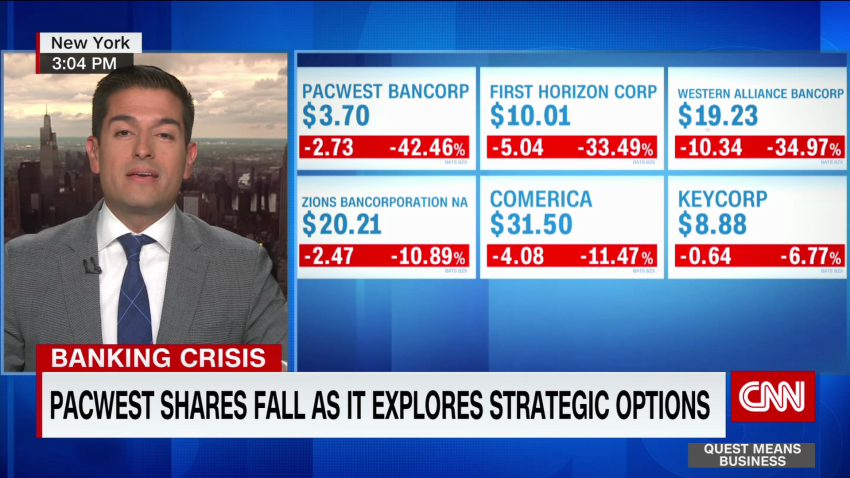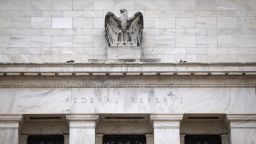It was already difficult for businesses and households to borrow money earlier this year — but after the collapse of three US regional banks and a cascade of rate hikes by the Federal Reserve, getting money has become a little harder.
More lenders have stiffened their standards in the wake of increasing turmoil within the banking sector, according to the Federal Reserve’s quarterly Senior Loan Officer Opinion Survey (SLOOS) released Monday.
Survey respondents attributed the changes in lending standards to economic uncertainty, a reduced appetite for risk, deterioration in collateral values and broader concerns about banks’ funding costs and liquidity positions, according to the Fed report. Additionally, lenders reported that they expect to tighten standards across all loan categories for the remainder of this year, citing the above concerns as well as customer withdrawals.
When banks tighten their standards, loans can be harder to get or come with more onerous terms, making it difficult for businesses to make capital improvements or hire staff; or for consumers to buy a house, purchase or lease a car or make home improvements.
“The impact of tightening credit to small businesses, which are very large employers, and banks are major providers of credit to small and mid-sized businesses,” Warren Kornfeld, senior vice president of Moody’s Investors Service, told CNN. “So depending on how long this tightening and how significant this tightening is, has the potential to have material impacts on how fast the economy grows.”
The report doesn’t typically garner a lot of attention from the public; however, that’s not the case now, after three large regional banks failed within a four-week span and the Fed is attempting a precarious “soft landing” — to bring down inflation without causing a ballooning in unemployment.
“Further evidence of tightening lending conditions and a potential credit crunch can be seen in the notable decline in demand for credit by large and middle market firms inside the [SLOOS],” Joseph Brusuelas, chief economist with RSM US, said in a statement. “Policymakers and investors should anticipate this to impact the real economy in the near term as investment, hiring and growth slow on the back of tighter lending.”
The Fed surveys up to 80 large US banks and 24 domestic branches of foreign banks and asks officers about topics such as changes in lending terms and standards as well as household demand for loans.
‘Banks are experiencing stress’
The last SLOOS, released in January and generally corresponding to activity in the fourth quarter of 2022, showed that standards tightened for most business loans, especially commercial real estate products.
Standards tightened and demand weakened for residential loans as well as consumer-specific categories such as credit cards, autos and personal loans.
At the time, banks expected that trend of tightening credit, waning demand and deteriorating loan quality would continue.
Then in March, two regional banks failed in quick succession. The Fed, Treasury and Federal Deposit Insurance Corporation stepped in to shore up the banking system and stave off future bank runs; however, uncertainty spiked as to potential ripple effects within the banking industry as well as the economy.
“Perhaps what [this SLOOS report points] toward … is it shows that there is some evidence that banks are experiencing stress,” Jill Cetina, associate managing director of Moody’s Investors Service, told CNN. “I think we knew that before the survey, but now we have that quantified here with how it’s impacting lending.”
For consumers, the impacts have been varied, according to a separate report released Monday by the Federal Reserve Bank of New York.
The sharp decline in perceived credit access and availability seen in March wasn’t replicated in this month’s survey results. In April, declines were seen by both the share of households reporting that it’s easier to obtain credit as well as the share of households reporting that it’s harder.
Still, household income growth expectations declined slightly, but a bigger drop was seen in spending growth expectations. Those fell to the lowest level since September 2021. The latest federal snapshots on consumer spending showed a cooling that economists say could be indicative of either people “retrenching” or returning to more typical spending patterns.
Fed president: Central bank should weigh effects
Federal Reserve Bank of Chicago President Austan Goolsbee said in an interview with Yahoo! Finance on Monday that “the credit crunch, or at least a credit squeeze, is beginning” and that it should be something Fed officials should strongly consider when deciding interest rates.
Fed officials, including Chair Powell, have previously noted that credit tightening could act similarly to a rate hike.
“You do not land the plane nose down, so we want to just make sure that these bank stresses — I don’t know if it’s full blown credit crunch, but it’s certainly credit tightening,” Goolsbee said. “You see from talking to the lending officers or business contacts out here in the Midwest, that will slow the economy and we absolutely should take that into account when we’re setting monetary policy.”
He added that industries that are more dependent on credit to carry out their operations would be “more directly affected.”
“We have to figure out how much of the work of monetary policy is getting done already through the credit conditions and we have to be mindful that that’s not going to be evenly distributed around the country,” he said.
A ‘salient risk’
Separately on Monday, the Fed released its semi-annual Financial Stability Report, which assesses the resilience of the US financial system.
Ongoing stresses in the banking vaulted up into a “salient risk” since the previous stability report was released in November. Other risks include: persistent inflation, monetary tightening, US-China tensions, commercial and residential real estate and Russia’s war in Ukraine, according to the report.
“A sharp contraction in the availability of credit would drive up the cost of funding for businesses and households, potentially resulting in a slowdown in economic activity,” according to the Fed report. “With a decline in profits of nonfinancial businesses, financial stress and defaults at some firms could increase, especially in light of the generally high level of leverage in that sector.”
Credit tightening does present risks to the economy, Treasury Secretary Janet Yellen told CNBC Monday in an interview. But she said she still believes a soft landing is possible.
“We can’t rule out a recession, but I don’t think that’s the most likely path,” she said.
— CNN’s Bryan Mena contributed to this report.






